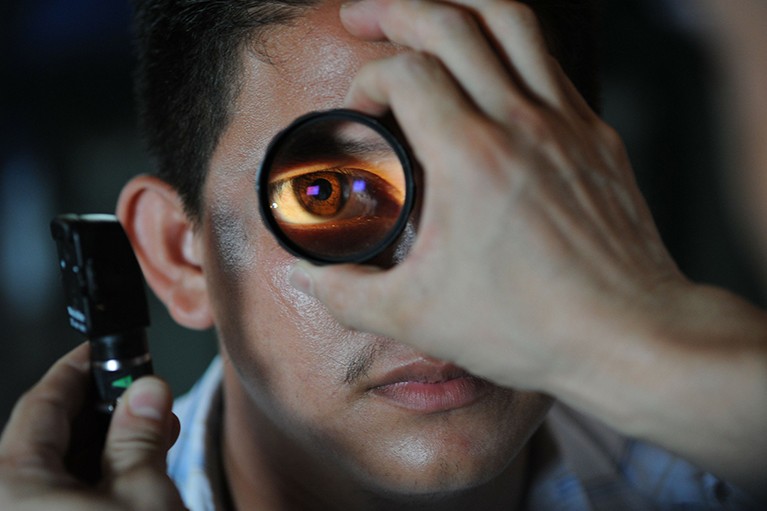Don't Let Glaucoma Steal Your Sight
January 7, 2022

More than 3.4 million Americans aged 40 years and older are blind or visually impaired. Other estimates of vision problems range as high as 21 million, and a total of 80 million Americans have potentially blinding eye diseases. The major causes of vision loss are cataracts, age-related macular degeneration, diabetic retinopathy, and glaucoma.
The Effects of Vision Loss
People with vision loss are more likely to report depression, diabetes, hearing impairment, stroke, falls, cognitive decline, and premature death. Decreased ability to see often leads to the inability to drive, read, keep accounts, and travel in unfamiliar places, thus substantially compromising quality of life.
As the population of older people continues to accelerate, the number of people experiencing vision loss will continue to increase. Some estimate that the population of people experiencing blindness and visual impairment will double by 2030 unless corrective actions are taken. Vision loss ranks among the top ten causes of disability in the United States, and is a condition feared by many.
Glaucoma - A Leading Cause of Vision Loss
Glaucoma is one the major vision-related diseases that affect an estimated 3 million Americans. Glaucoma is a group of diseases that damage the eye’s optic nerve and can result in vision loss and even blindness. Open-angle glaucoma, the most common form, results in increased eye pressure. There are often no early symptoms, which is why 50% of people with glaucoma don’t know they have the disease. There is no cure for glaucoma, but if it’s caught early, you can preserve your vision and prevent vision loss. Taking action to preserve your vision health is key.
Anyone can get glaucoma, but certain groups are at higher risk. These groups include African Americans over age 40, all people over age 60, people with a family history of glaucoma, and people who have diabetes. African Americans are 6 to 8 times more likely to get glaucoma, while people with diabetes are 2 times more likely to get glaucoma than people without diabetes.
Some people with glaucoma have low vision, which means they have a hard time doing routine activities even with the help of glasses or contacts.
Even if you’re not in a high-risk group, getting a comprehensive dilated eye exam by the age of 40 can help catch glaucoma and other eye disease early. While maintaining a healthy weight, controlling your blood pressure, being physically active, and avoiding smoking will help you avoid vision loss from glaucoma.
Managing and Treating Glaucoma
Vision loss from glaucoma usually affects peripheral vision (what you can see on the side of your head when looking ahead) first. Later, it will affect your central vision, which is needed for seeing objects clearly and for common daily tasks like reading and driving.
Glaucoma is treated with eye drops, oral medicine, or surgery (o ra combination of treatments) to reduce pressure in the eye and prevent permanent vision loss. Take medicine as prescribed, and tell your eye care specialist about any side effects. If laser or surgical procedures are recommended to reduce the pressure in your eye, make sure to schedule regular follow-up visits to continue to monitor eye pressure.
Take Action to Prevent Vision Loss
There are many steps you can take to help protect your eyes and lower your risk of vision loss from glaucoma. If you are in a high-risk group, get a comprehensive dilated eye exam to catch glaucoma early and start treatment. Prescription eye drops can stop glaucoma from progressing. Your eye care specialist will recommend how often to return for follow-up exams. Getting screened early is important to especially for those in high-risk groups as certain diseases such as open-angle glaucoma which does not have symptoms, and is hereditary.
Stay on top of your health and know your status by getting your vision checked regularly, especially if you are part of high-risk group. Don’t let glaucoma steal your sight!
Take Action to Prevent Vision Loss
There are many steps you can take to help protect your eyes and lower your risk of vision loss from glaucoma. If you are in a high-risk group, get a comprehensive dilated eye exam to catch glaucoma early and start treatment. Prescription eye drops can stop glaucoma from progressing. Your eye care specialist will recommend how often to return for follow-up exams. Getting screened early is important to especially for those in high-risk groups as certain diseases such as open-angle glaucoma which does not have symptoms, and is hereditary.
Stay on top of your health and know your status by getting your vision checked regularly, especially if you are part of high-risk group. Don’t let glaucoma steal your sight!
Sources:

